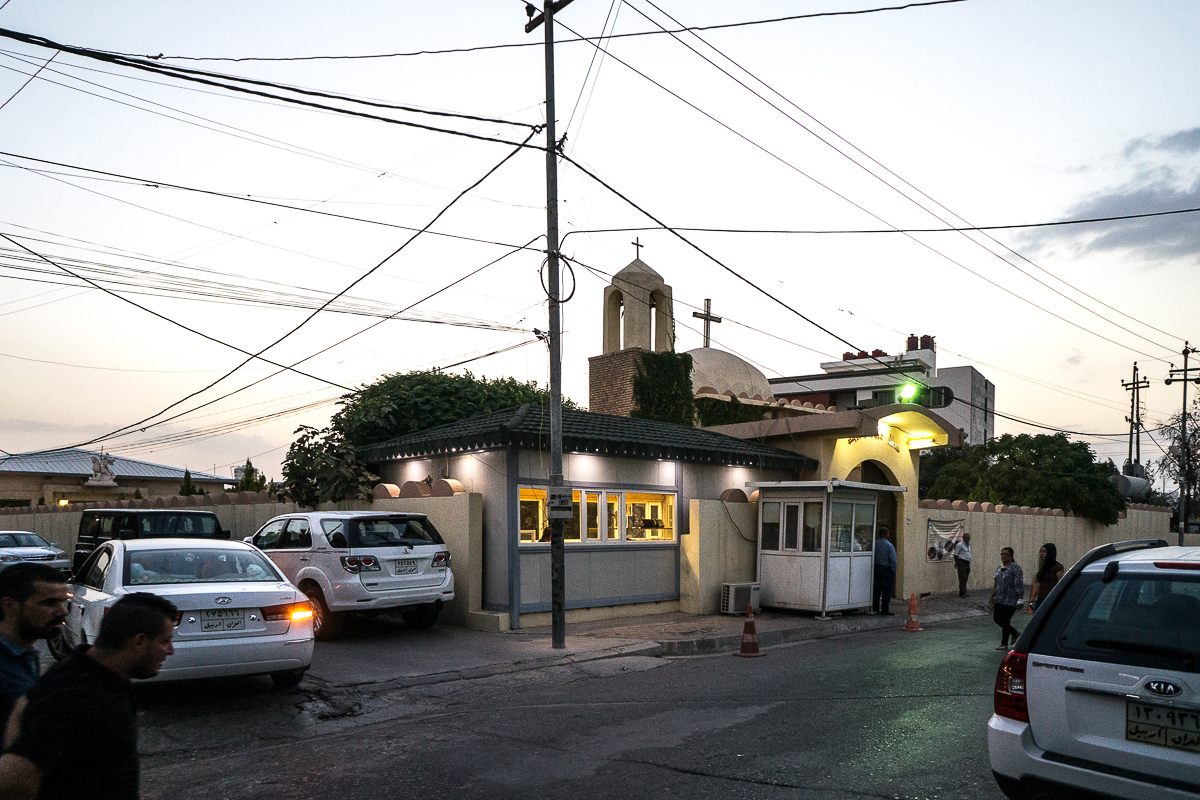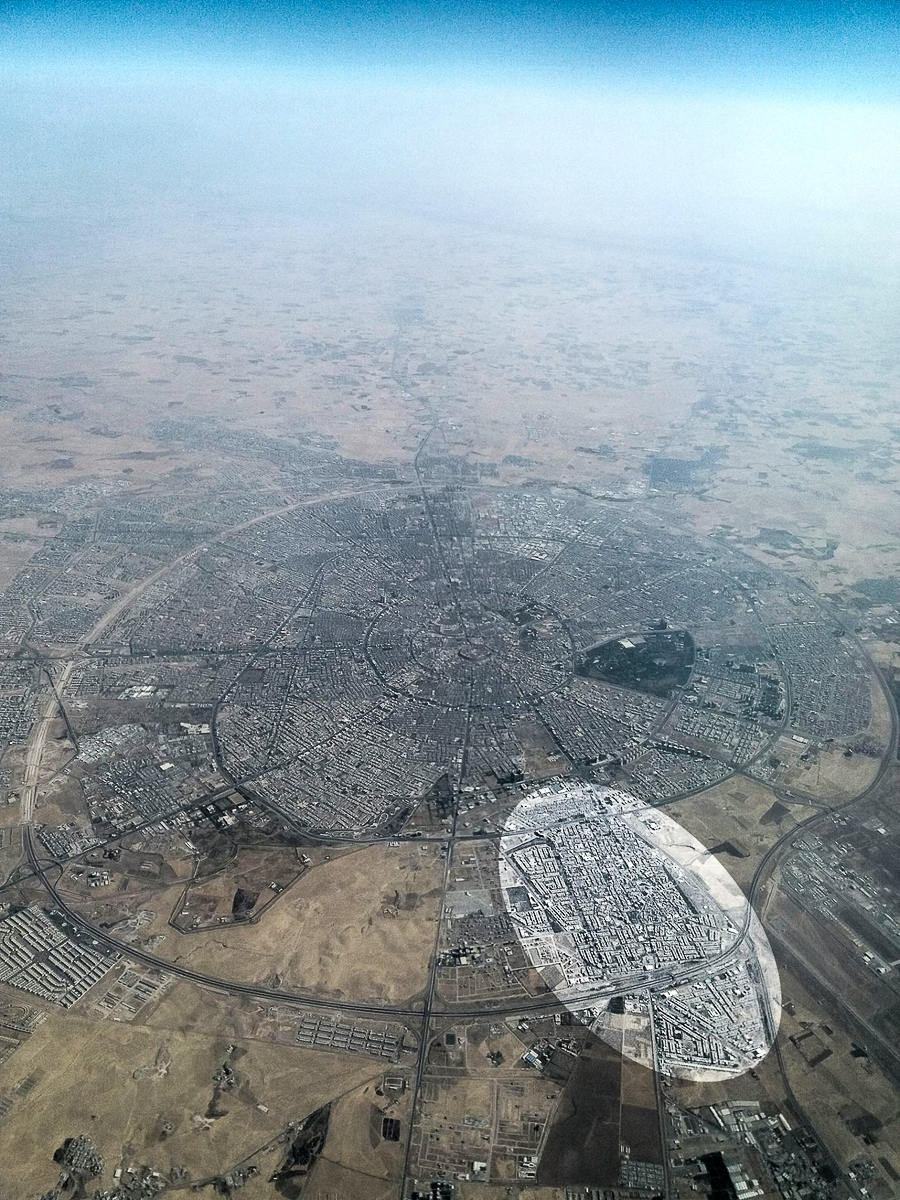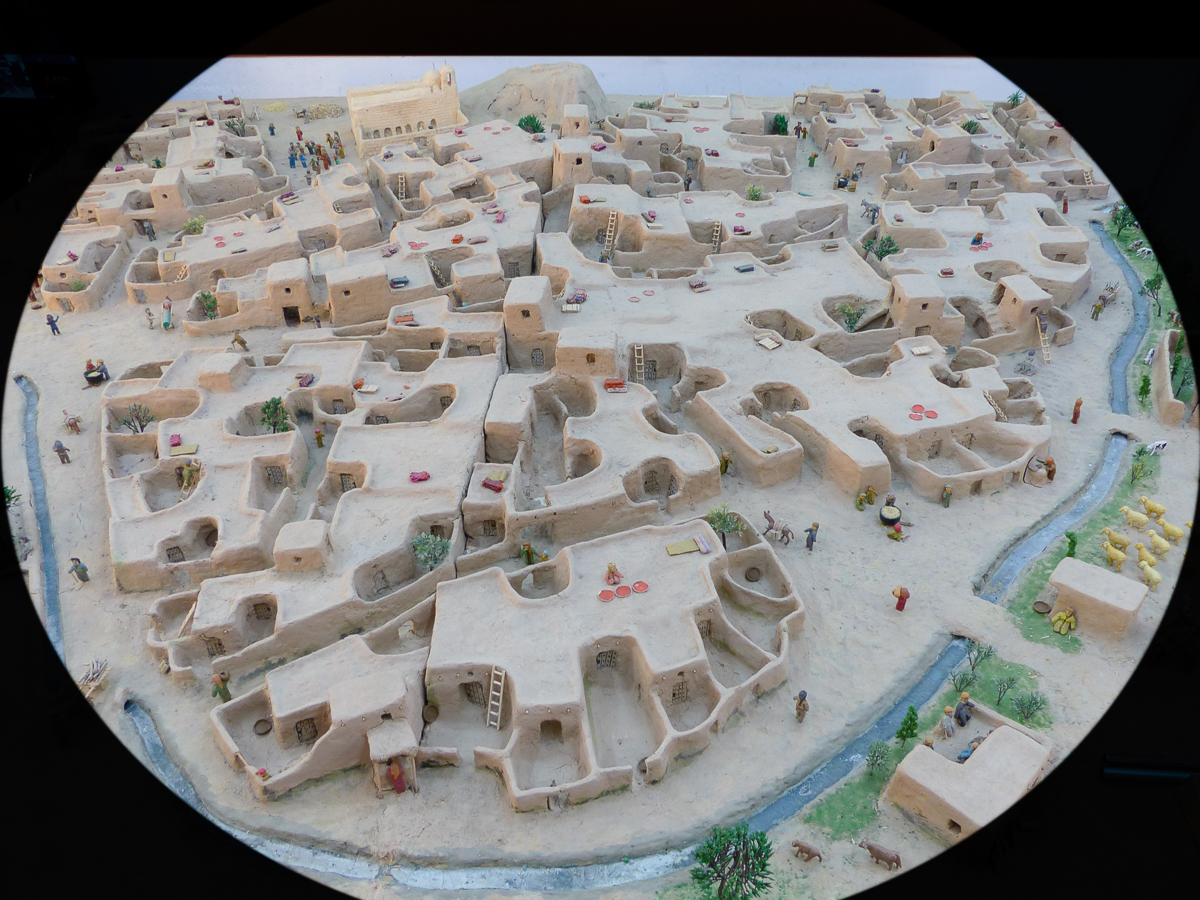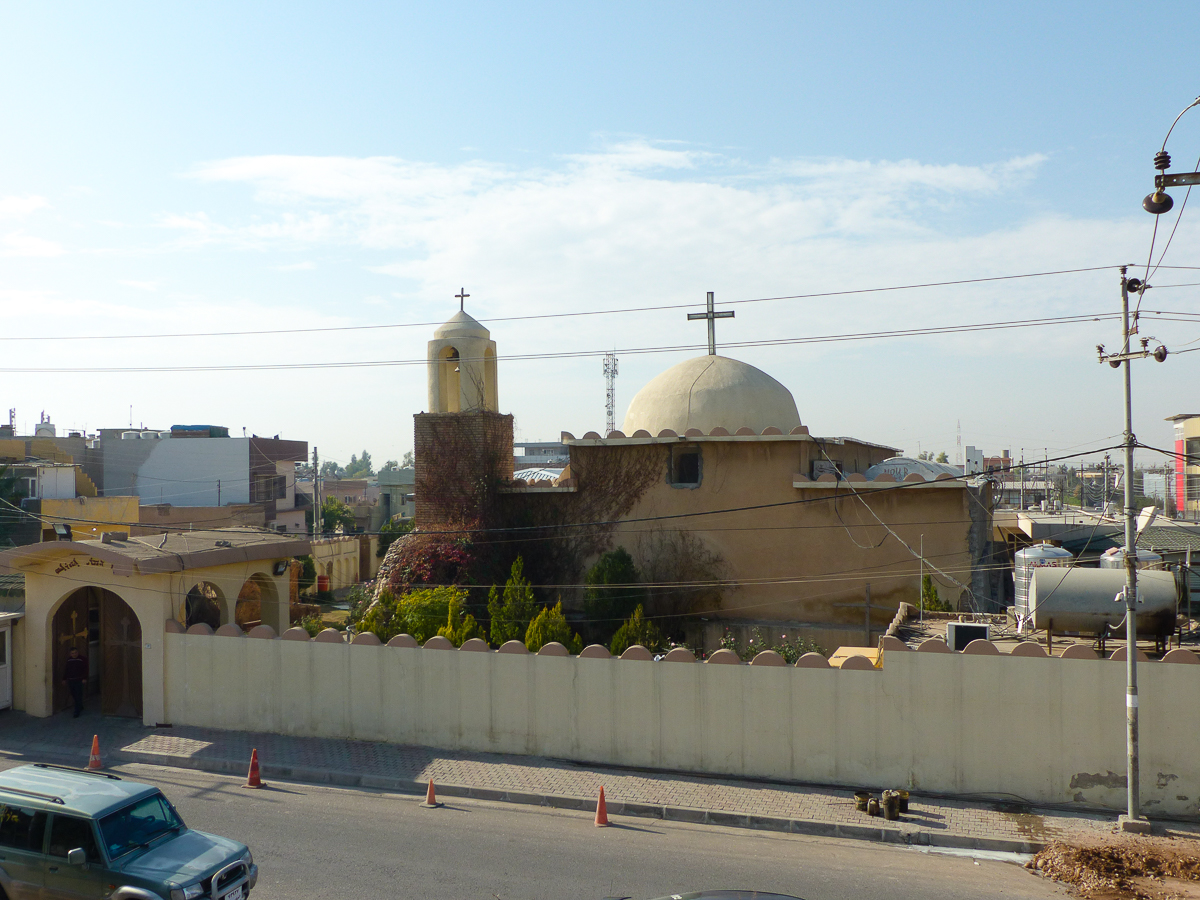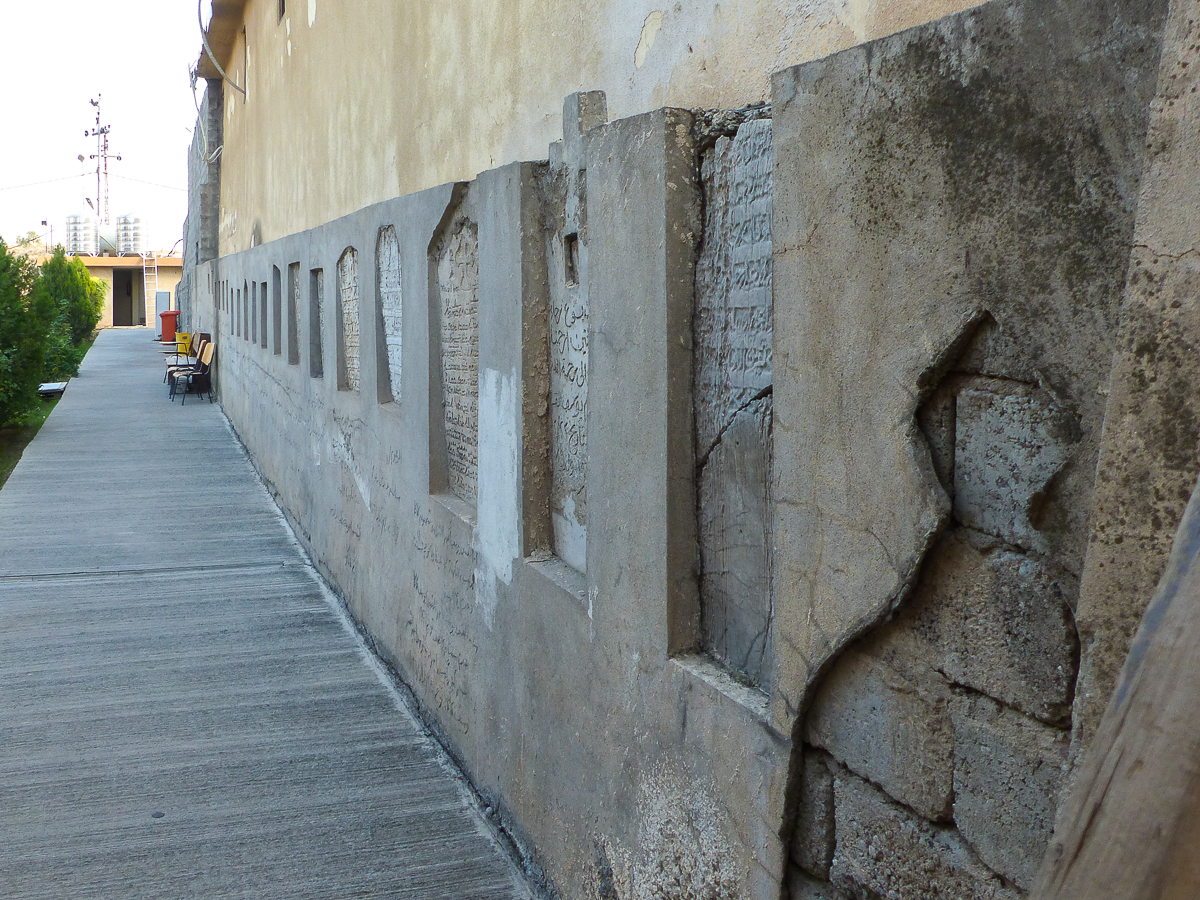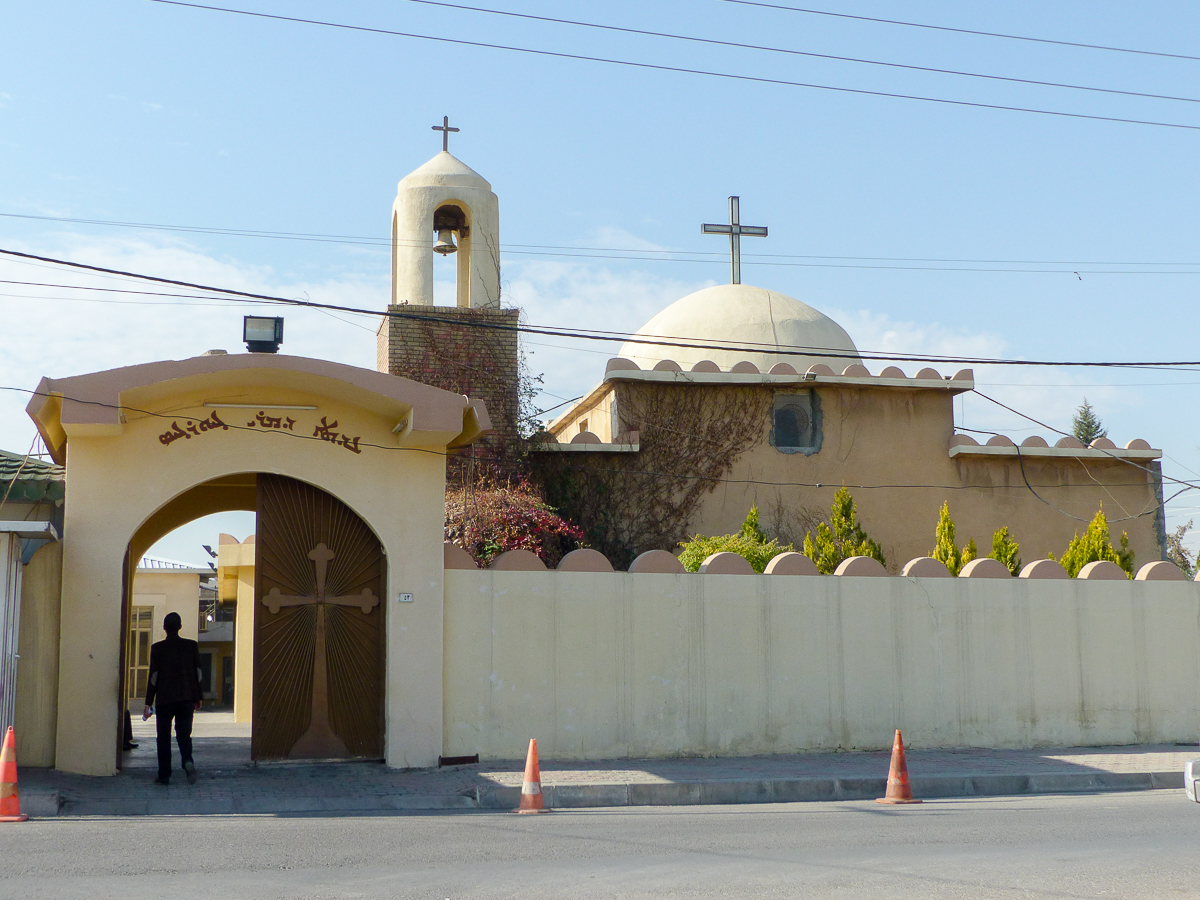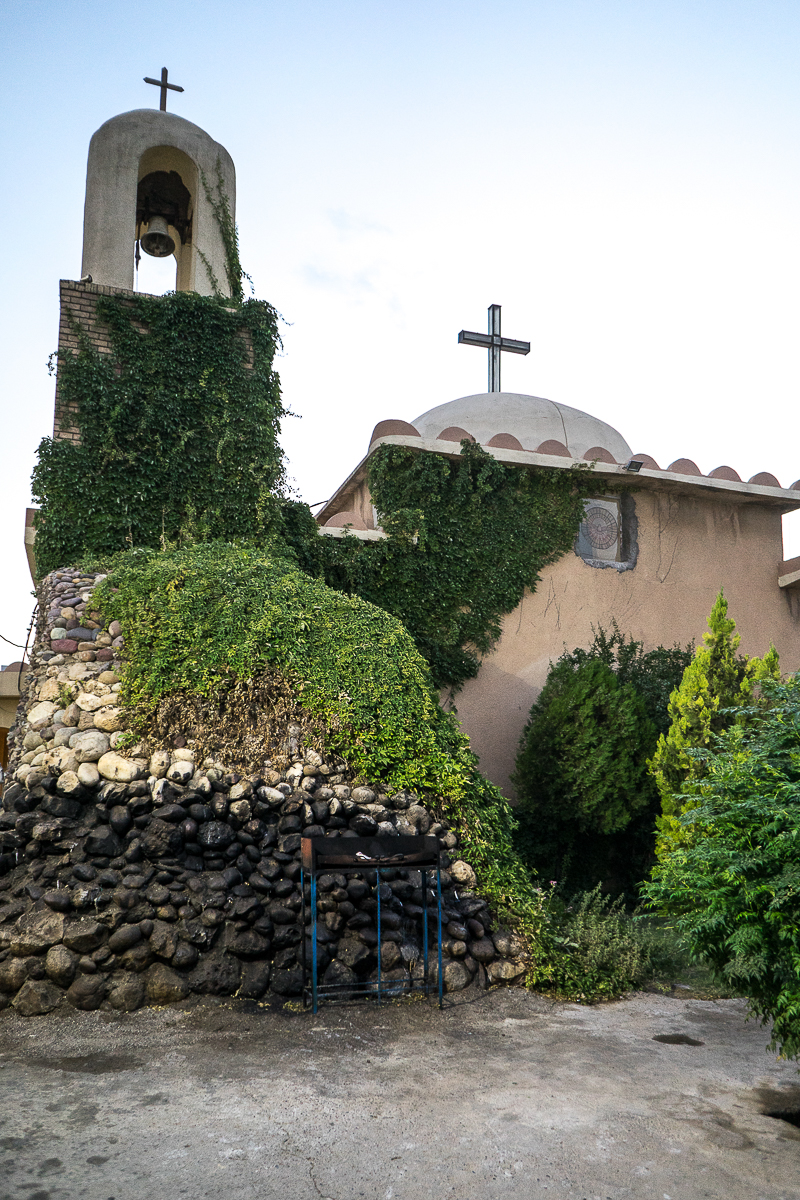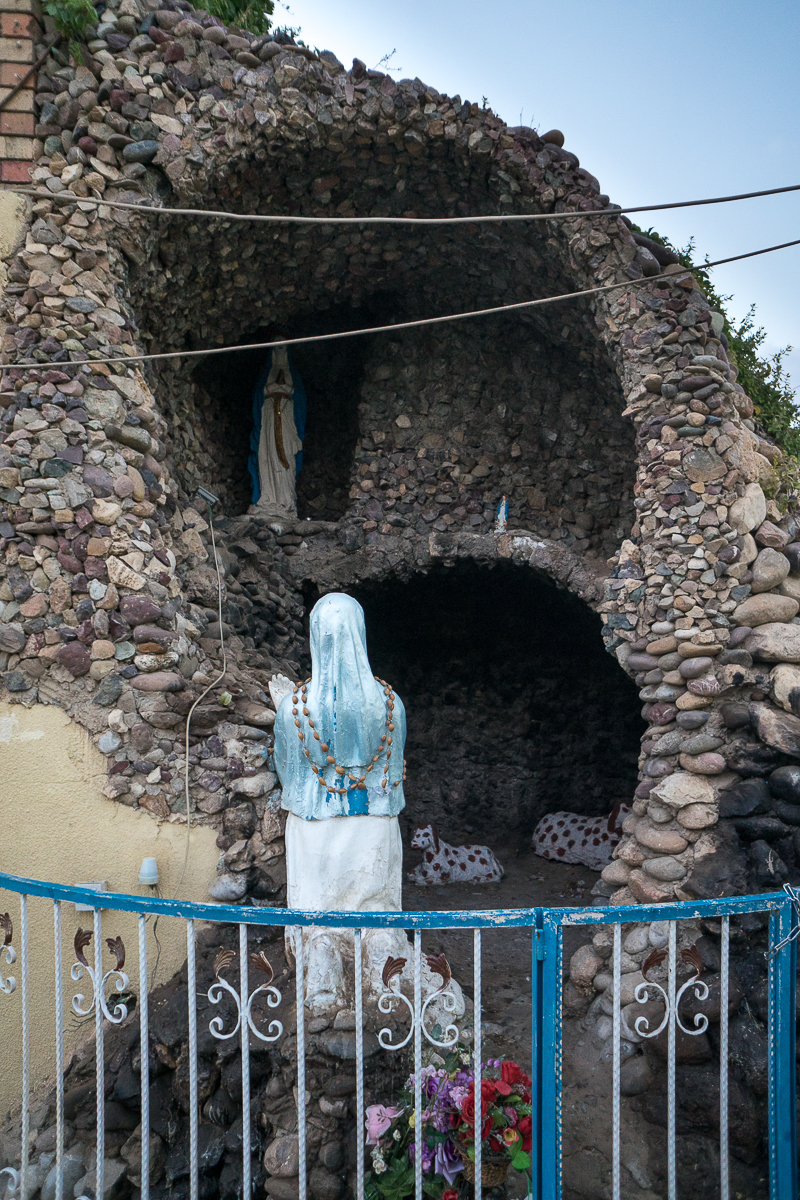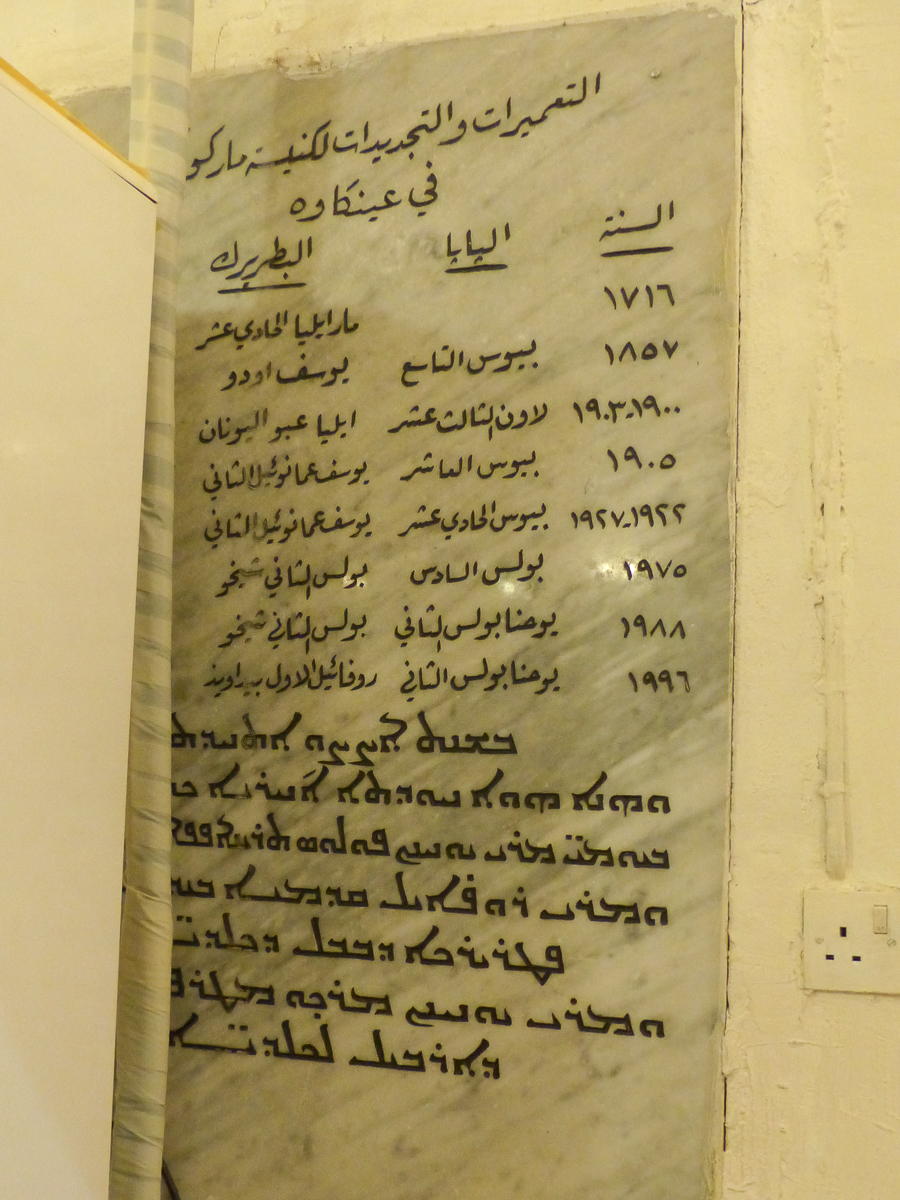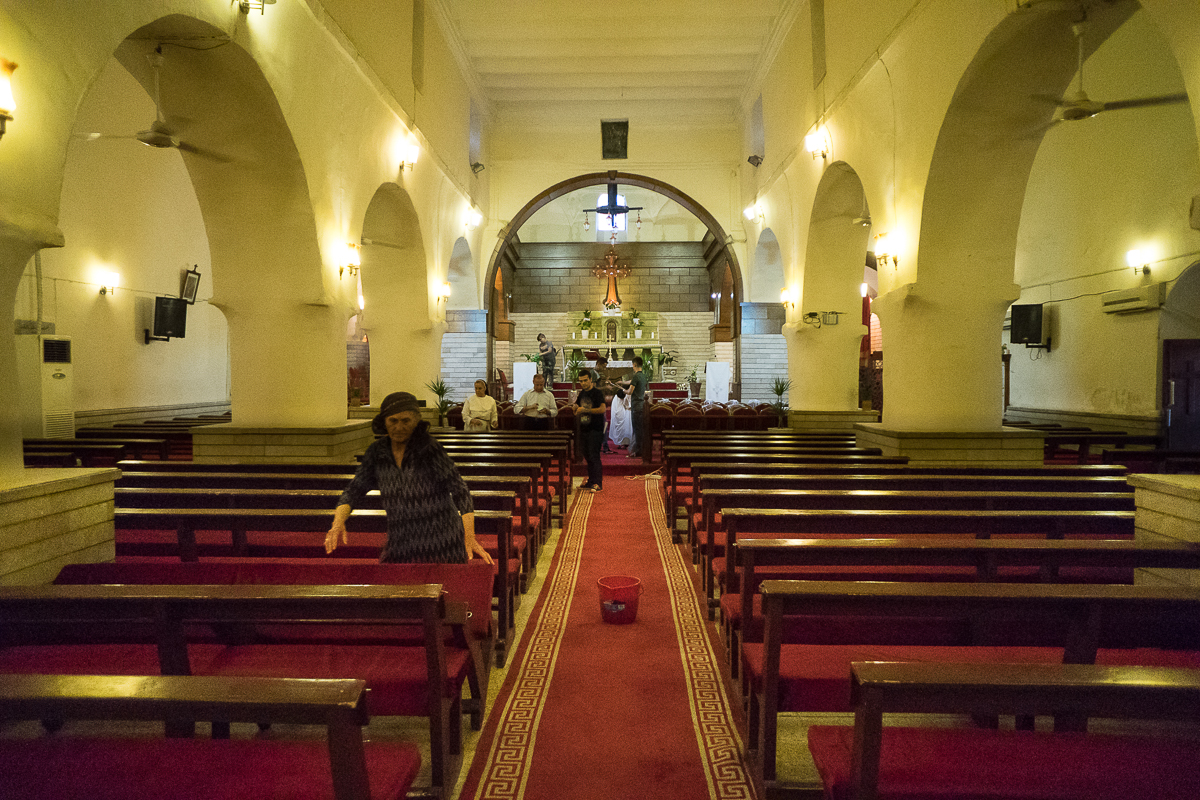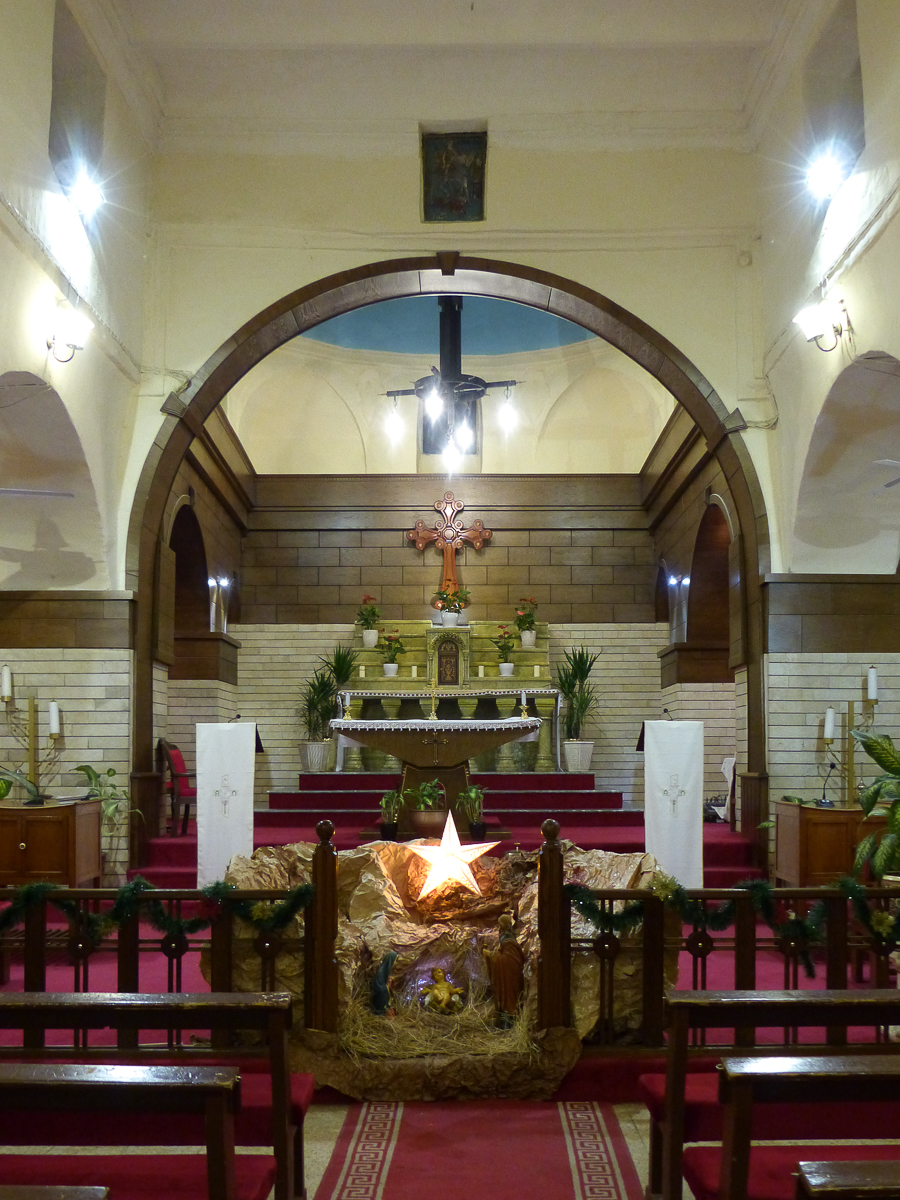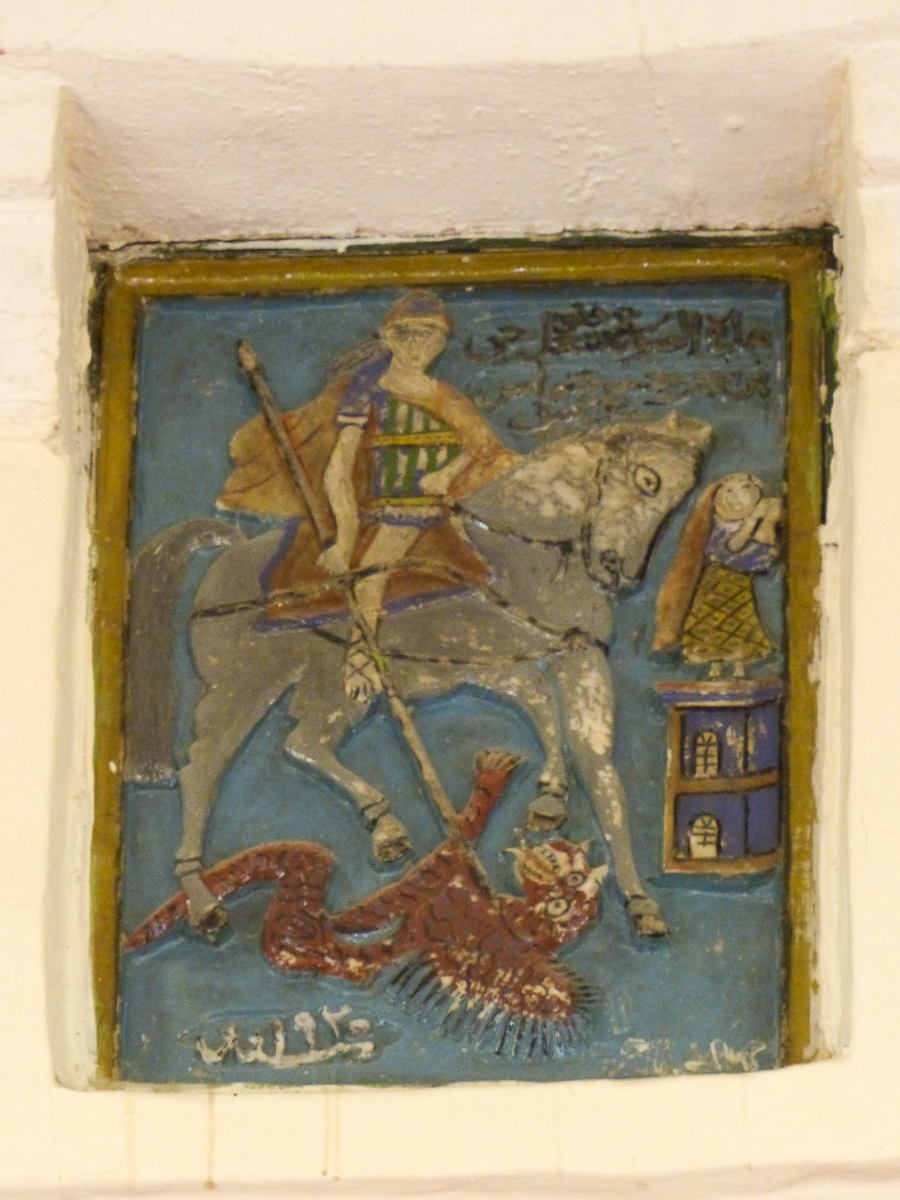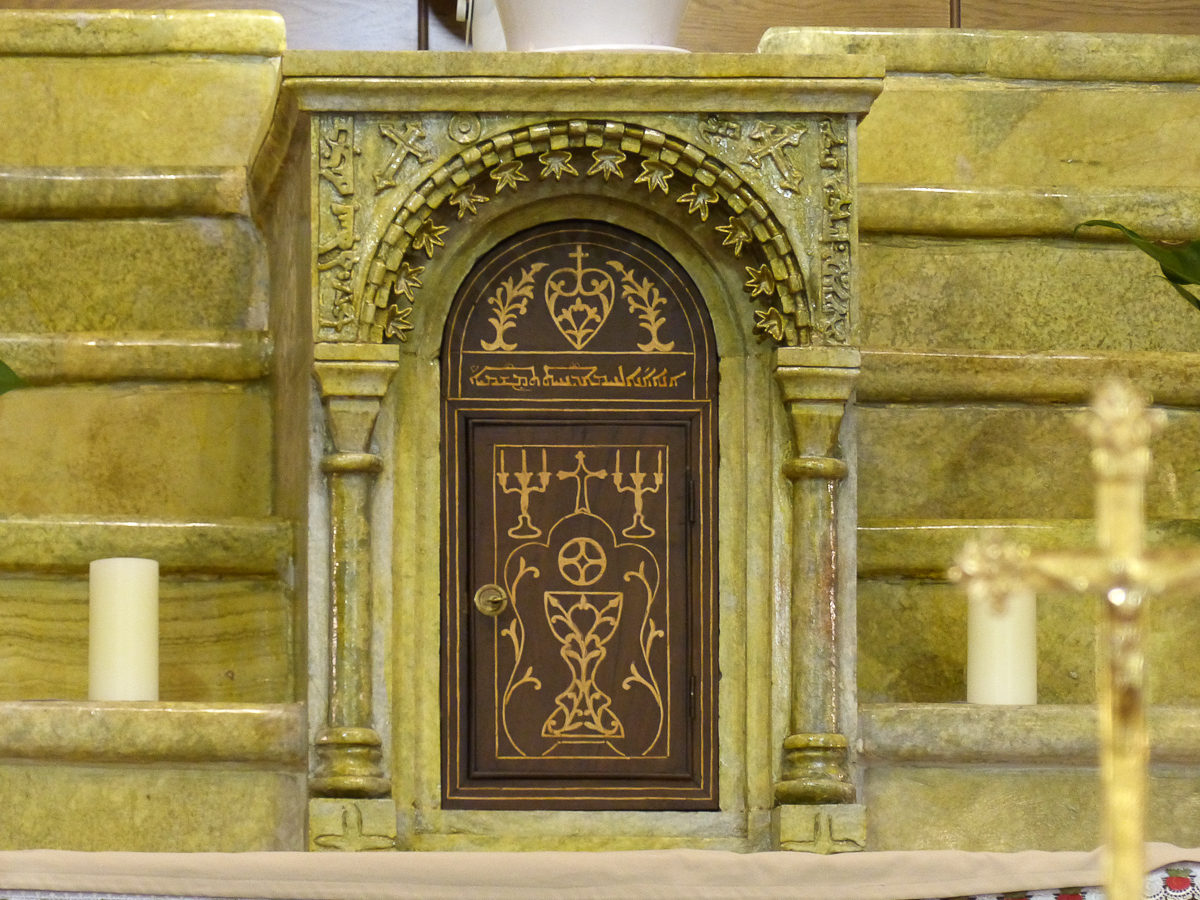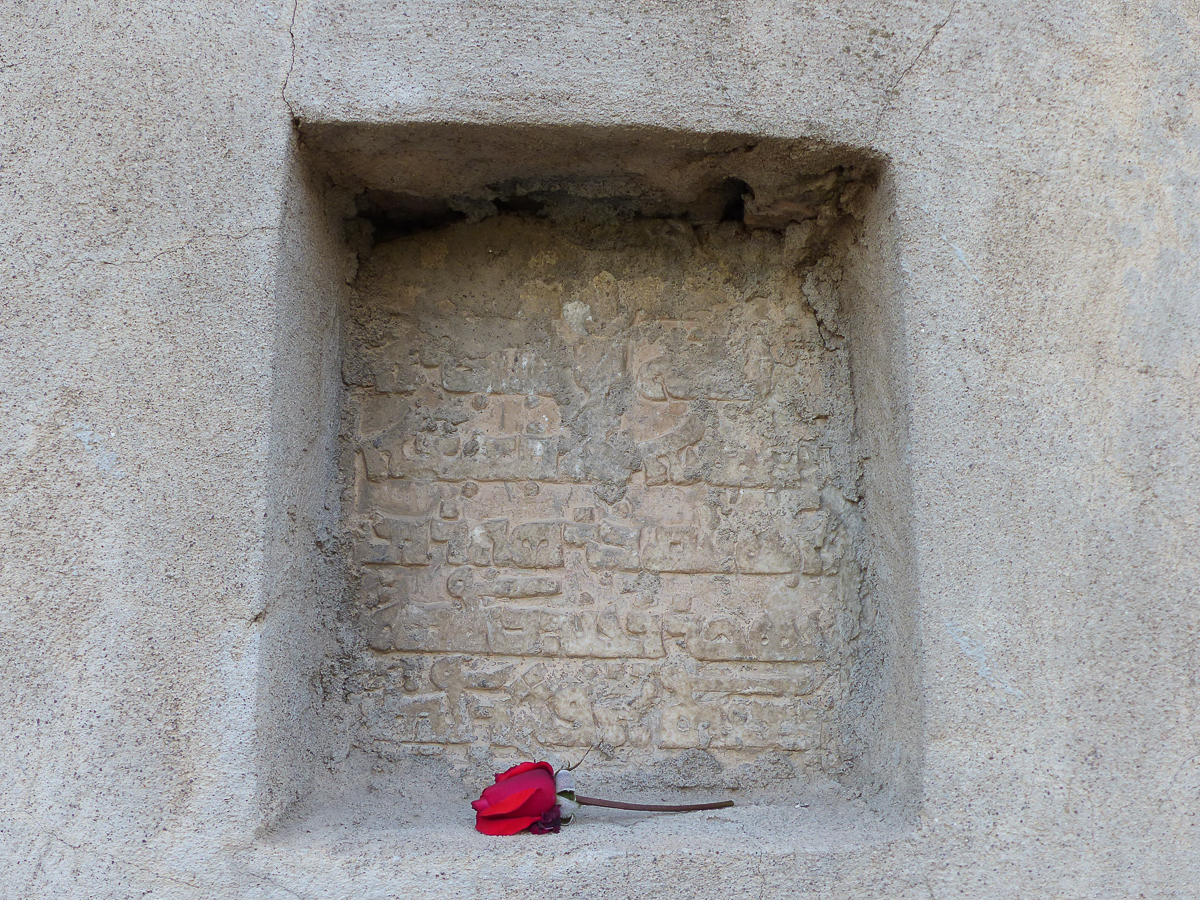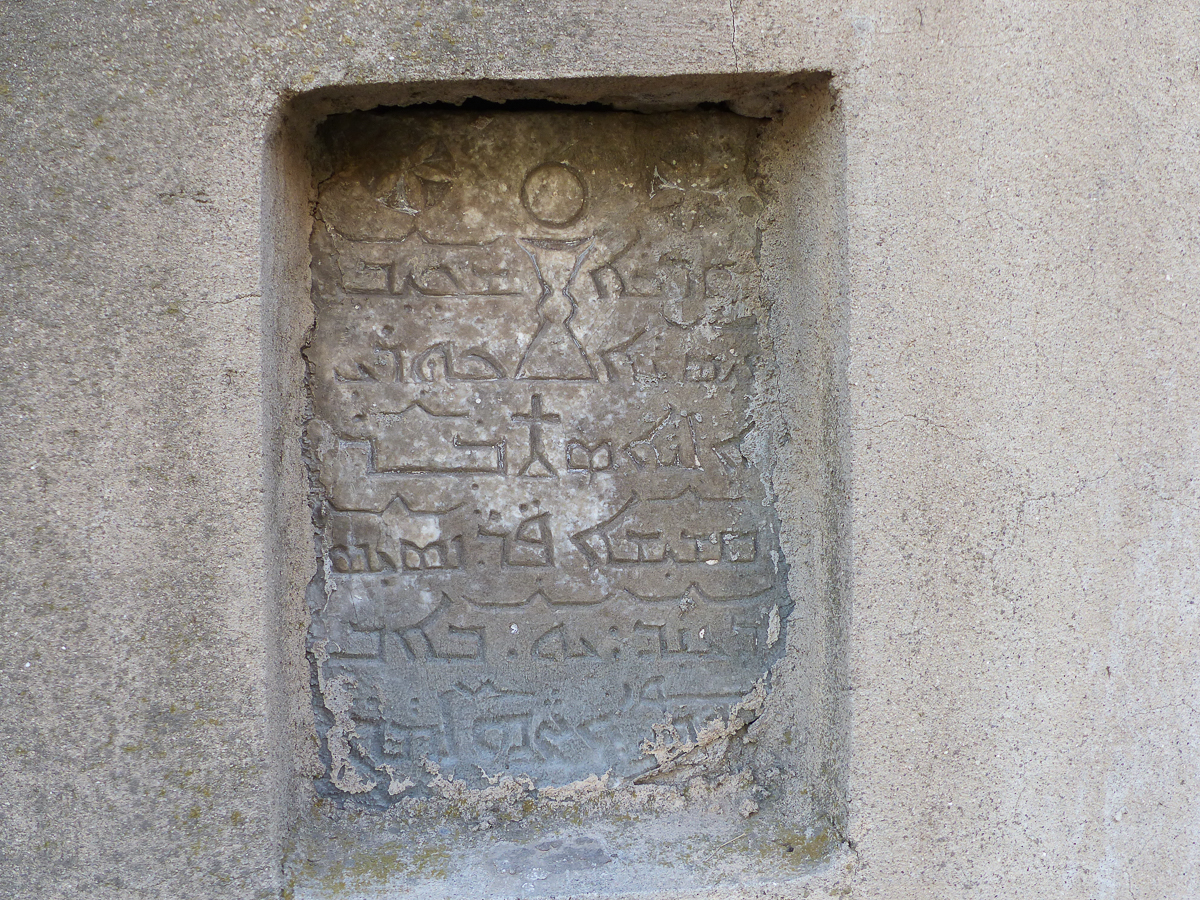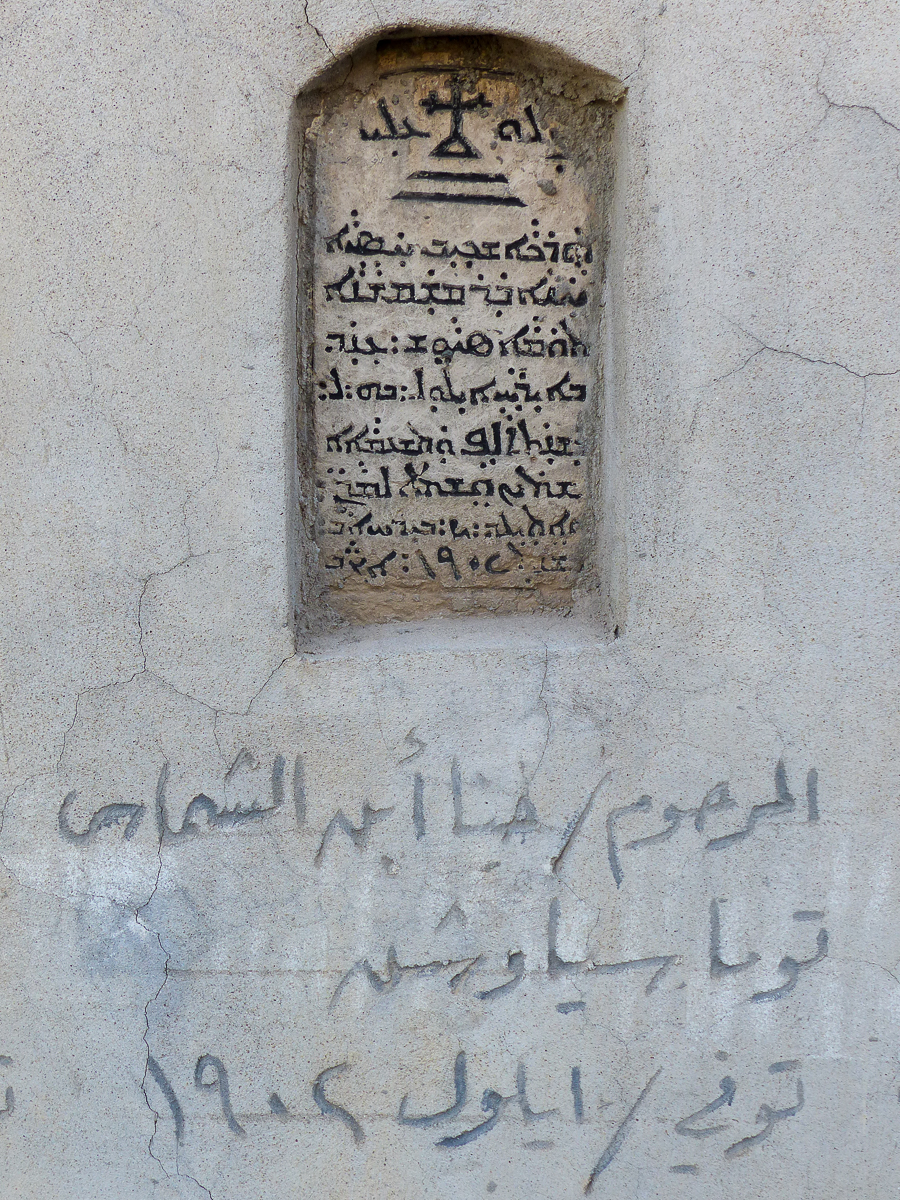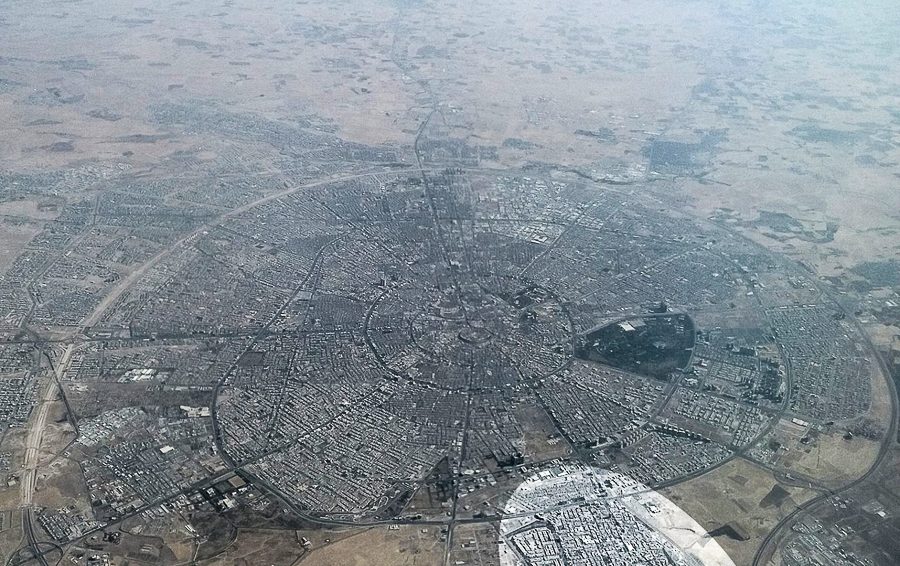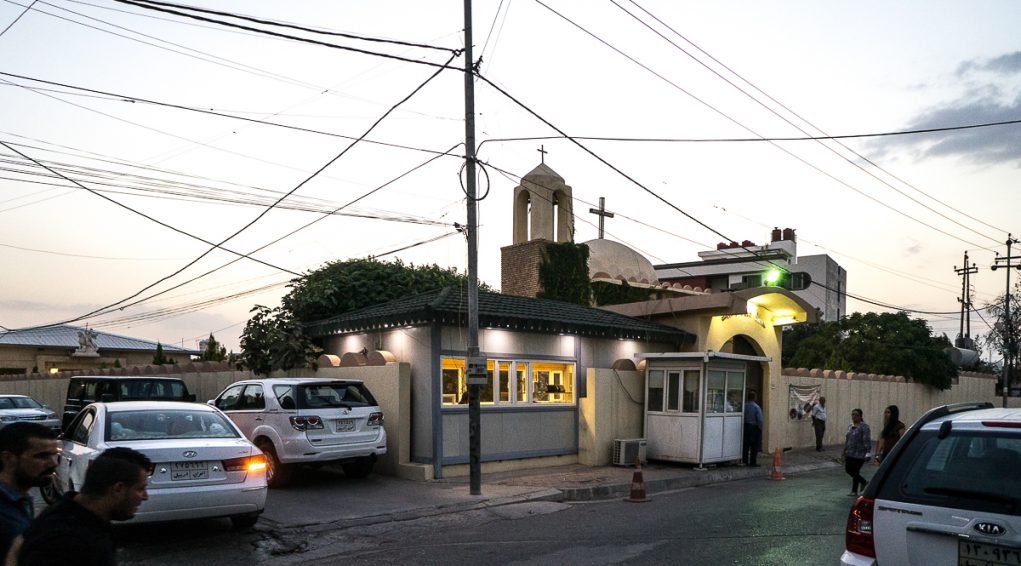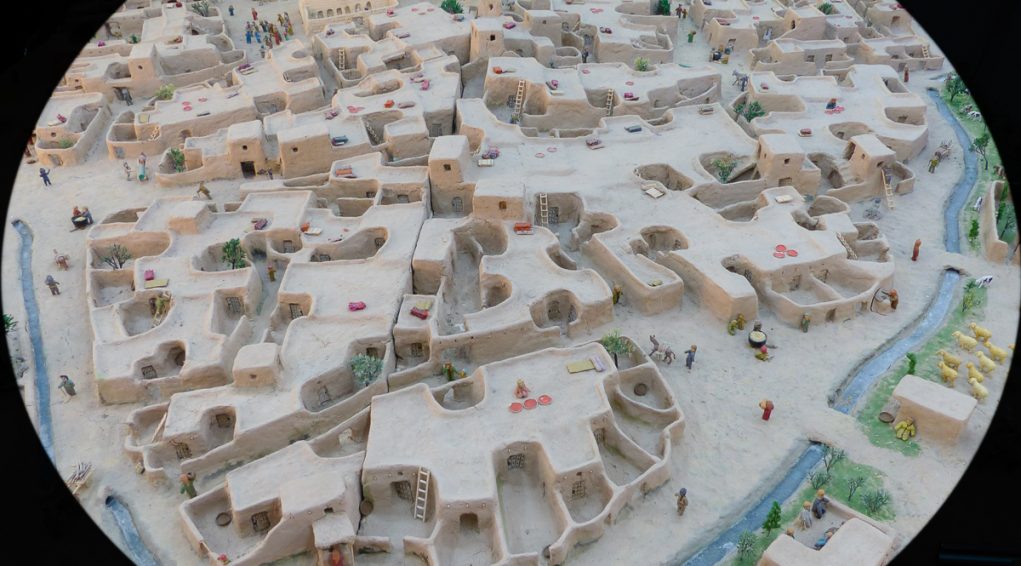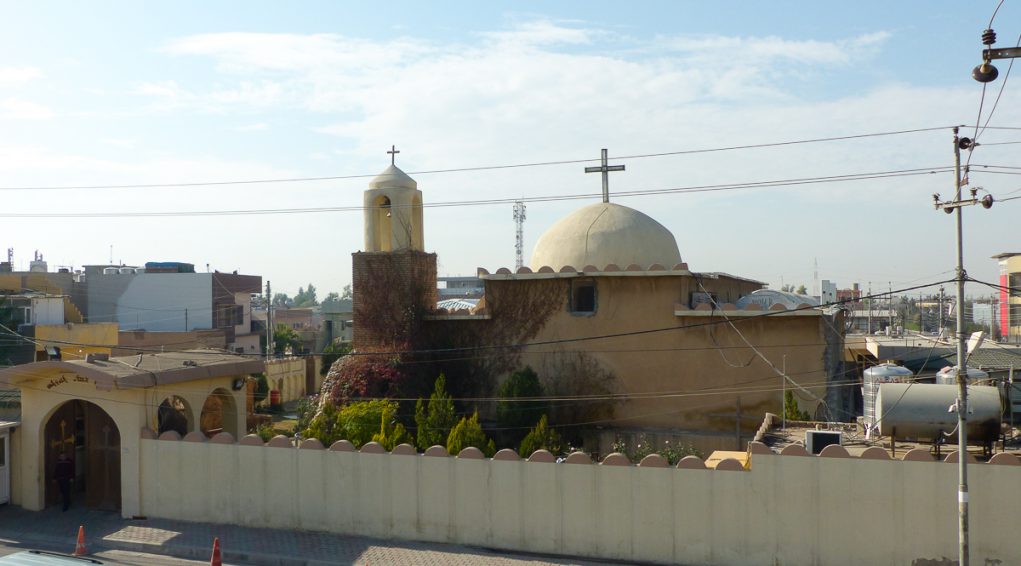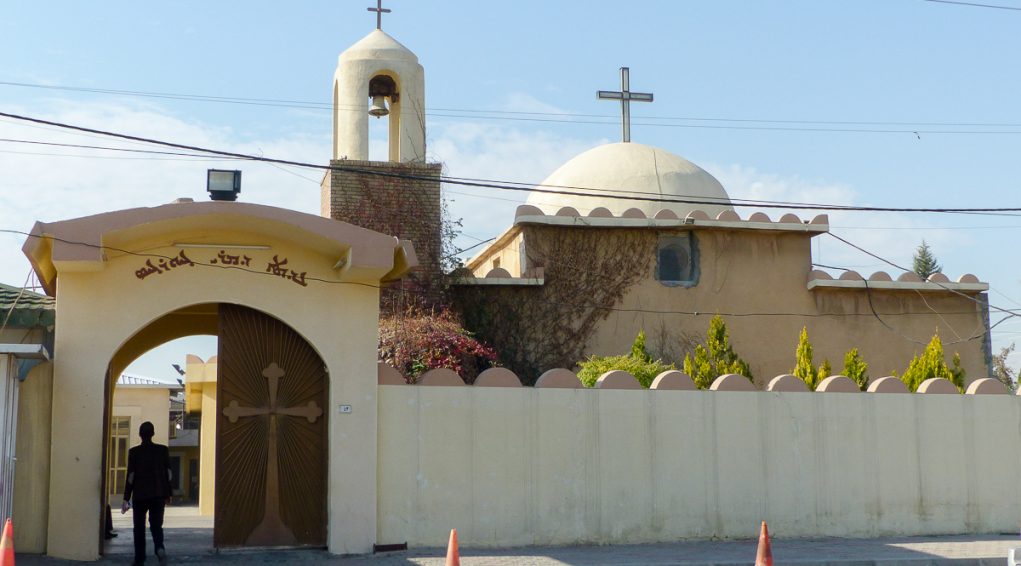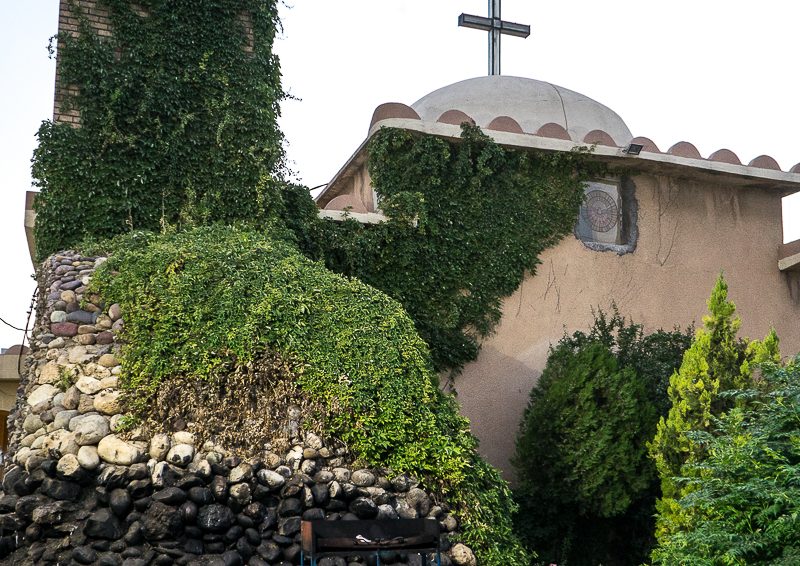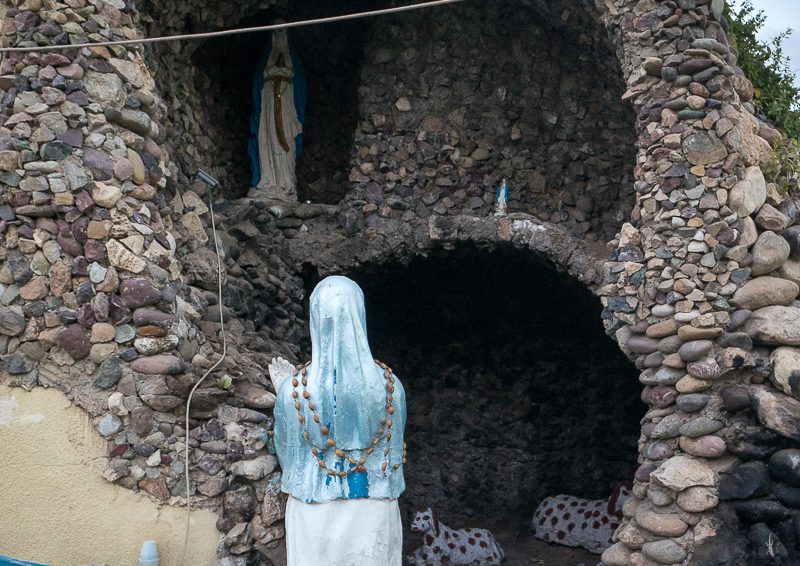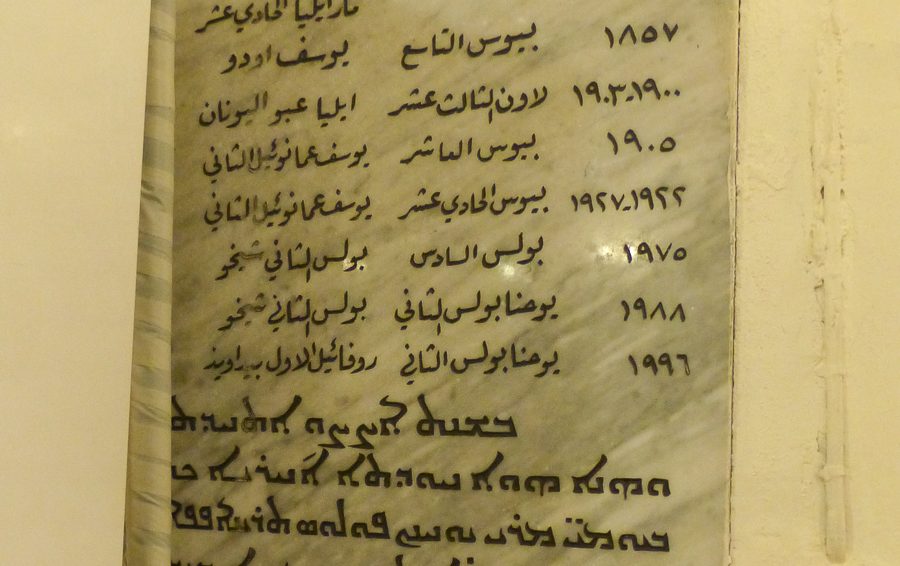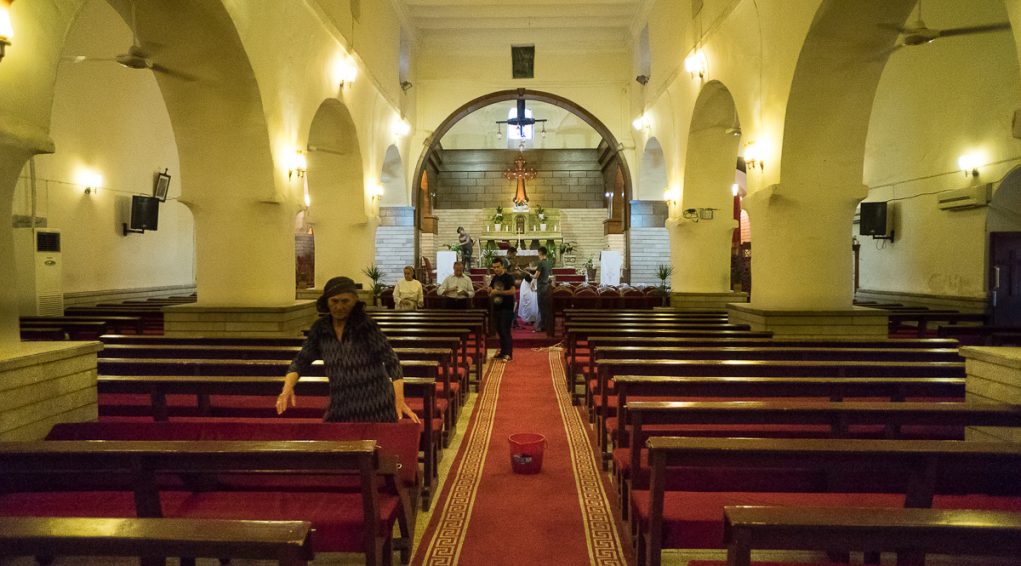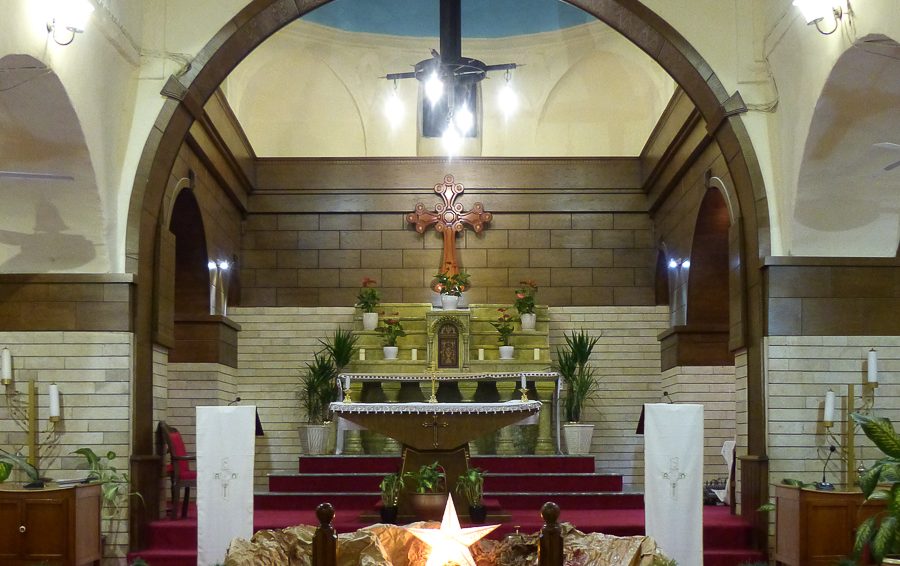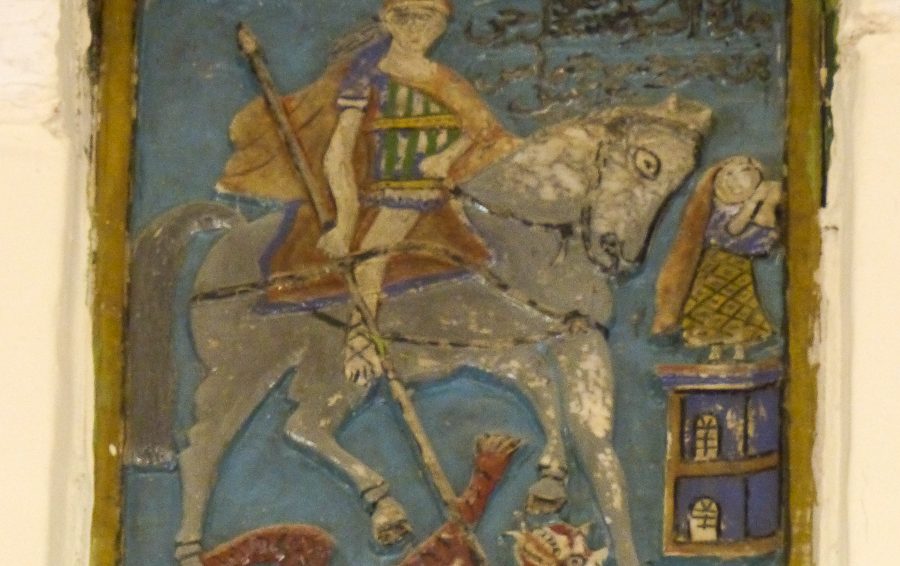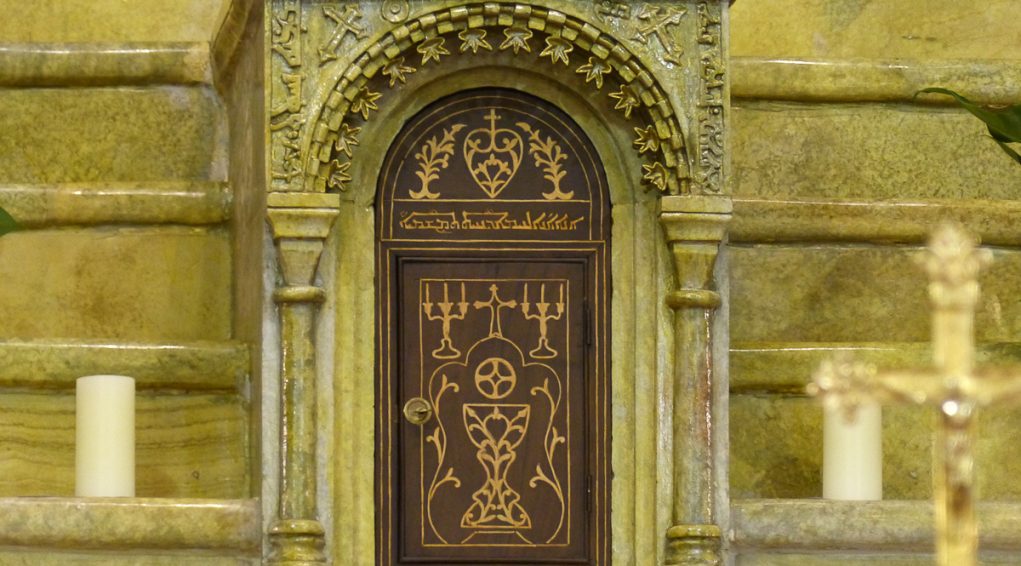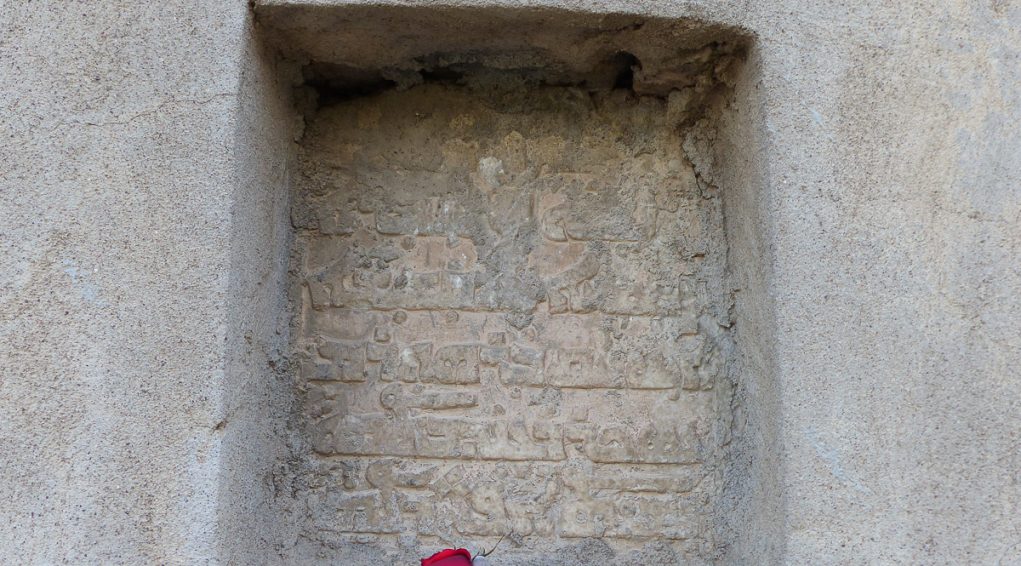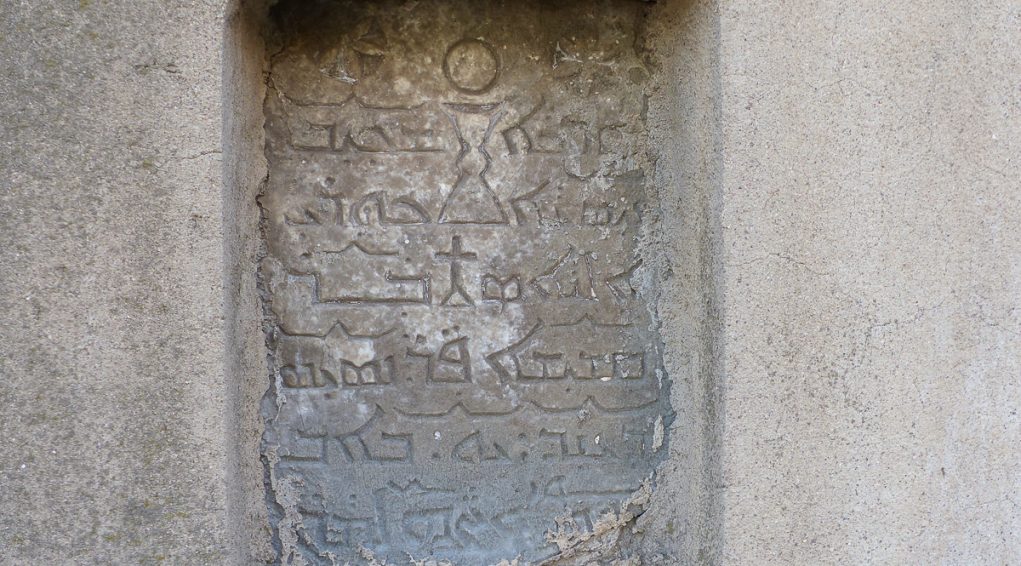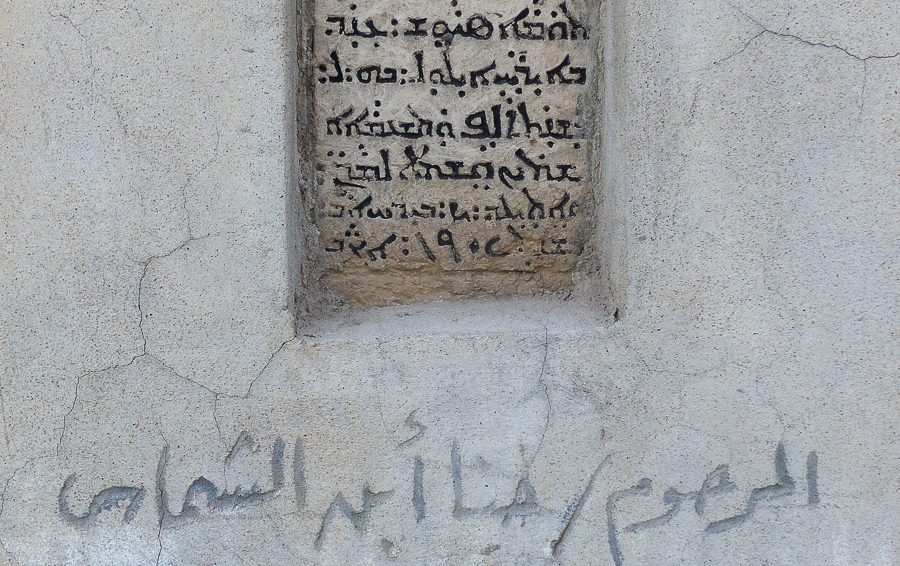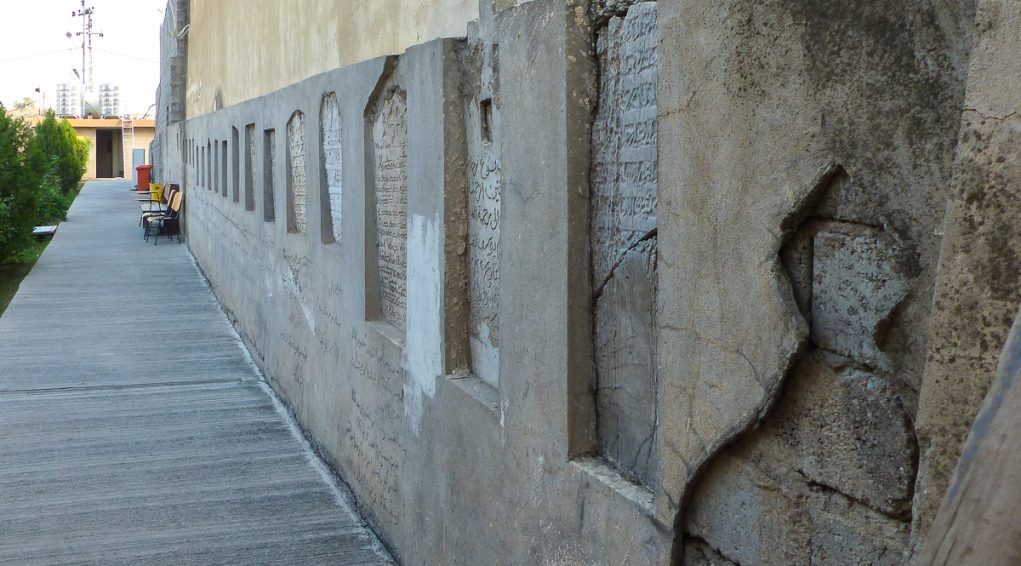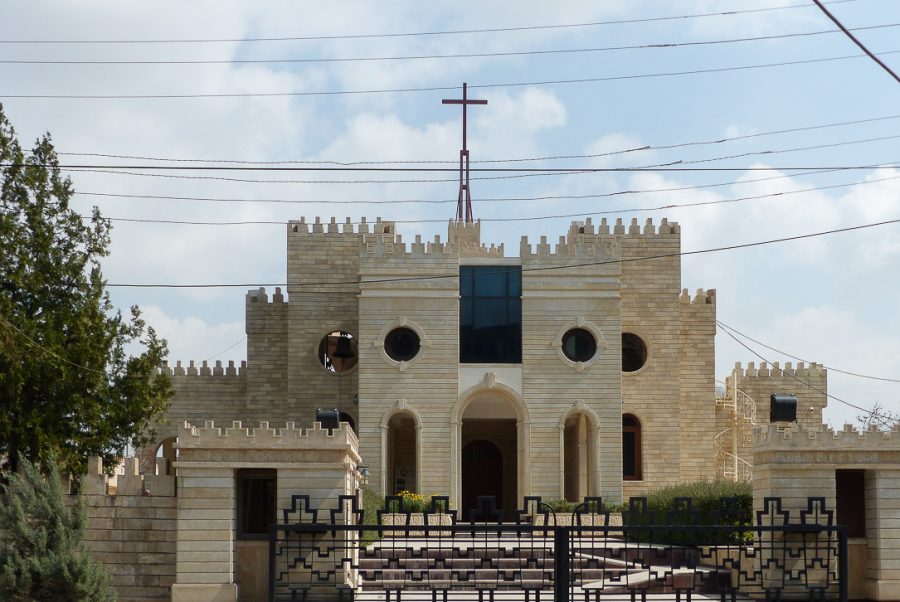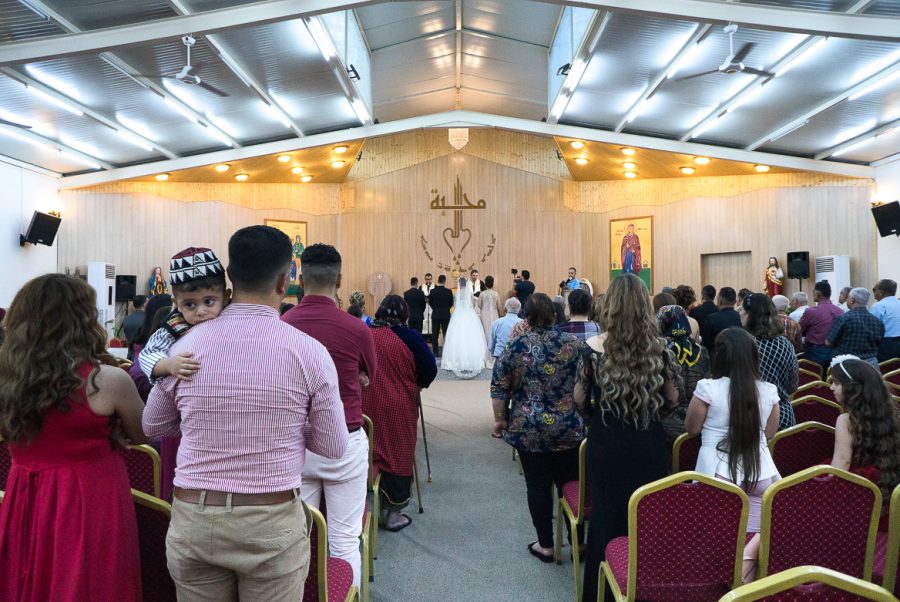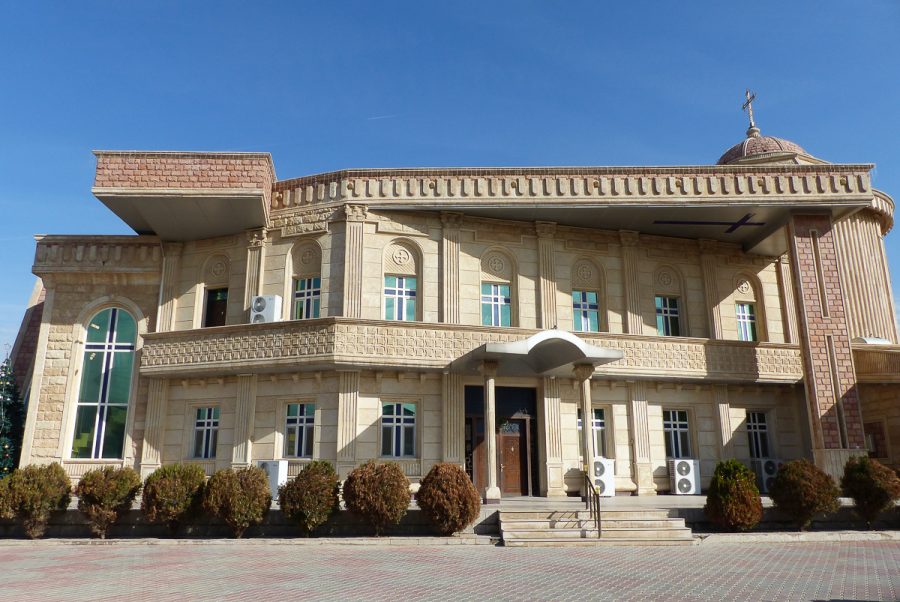Mar Gewargis Church in Ankawa
Mar Gewargis (Gorgis) church in Ankawa lies at 36°14’0.22″N 43°59’17.46″E and 413 metres high.
It is dedicated to the most revered patron saint of the Christian East.
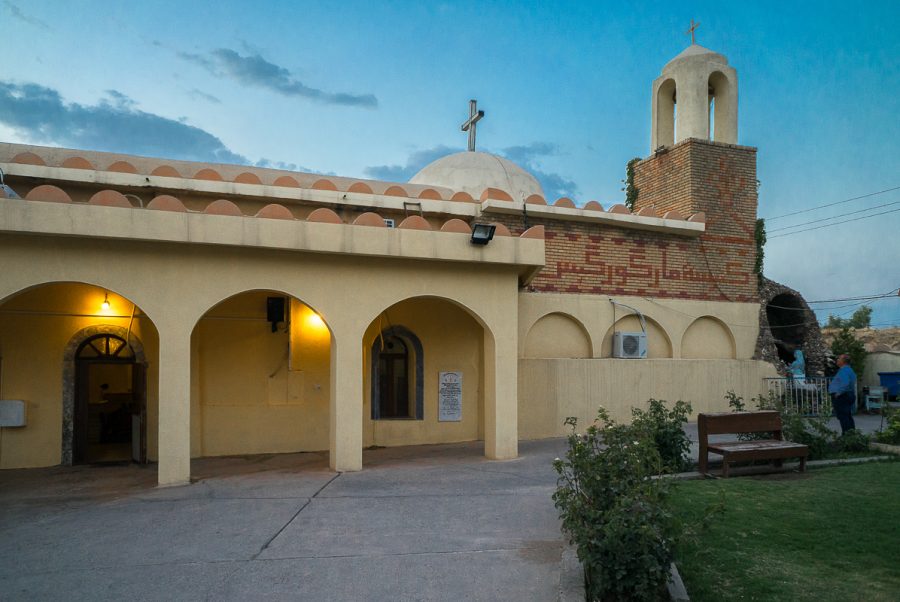
Mar Gewargis church in Ankawa is for sure one of the most ancient church of the city. After being rebuilt several times, the current building with its present structure may date back to the 19thcentury, and was last restored in 1995-1996. The garden, situated north-west from the church, used to be a graveyard, and numbers of gravestones that were in the garden, have been embedded within the north-western wall of the church, during restoration works and reorganization of the spaces.
Plan of Mar Gewargis church :
In« Les églises et monastères du “Kurdistan irakien“à la veille et au lendemain de l’islam », p. 228. PhD thesis by Narmen Ali Muhamad Amen at the University of Saint Quentin en Yvelines, under the direction of George Tate and the co-direction by Jean-Michel Thierry. May 2001.
Location
Mar Gewargis church in Ankawa[1]lies 36°14’0.22″N 43°59’17.46″E and 413 metres high, in a Christian suburb of the large urban district of Erbil[2]. Ankawa used to be a little village outside the northern gate of the Erbil citadel (Amkabad gate). Ankawa is today fully integrated in the Erbil metropolitan area, and its gravity centre remains the citadel around which the town is organized and grows in circles.
As capital city of the Autonomous Region of Iraqi Kurdistan, Erbil counts 1.5 million inhabitants. It lies in the plain, 30 km east from the Great Zab, an affluent of the Tigris River, 80 km east from Mosul and 25 km south from the southern border shaped by the Kurdish mountain.
Mar Gewargis church stands in the northern part of Ankawa, just opposite a tell (hill), dating back to Asyrian times, called Qasra (the castle), and where the foundations of a very ancient church dedicated to Mar Gewargis as well as diverse objects worthy of archaeological interest have been unearthed thanks to excavations
[1]The name Ankawa is used nowadays. In his work Assyrie Chrétienne,vol.I,Jean-Maurice Fiey reports that the city used to be called « ‘Amk Ābād in Persians’ times. From that name, came the name ‘Amkāwa (confirmed in the 14th century), sometimes abbreviated to ‘Amko (already in the 10thcentury). It is only later that the distorted version of ‘Ankāwa appears (18thcentury), then the modern ‘Aïnkāwa..». In the nameAmkabad, the suffix abad, coming from the Persian language, means « the residence of… »
Fragments of Christian history
Erbil, also referred to as the antique Assyrian city of Arbeles, is quite close from the presumed place of the plain of Gaugamela, where the famous battle took place, offering Alexander the Great a large victory on the Persian Darius III in 331 BC. Former capital city of the Assyrian kingdom of Adiabene, a kingdom that used to be shunted from the Parthian, to the Roman or to the Armenian empires, the area is famous for being in the 1stcentury one of the Jewish community in Mesopotamia that the Christians undoubtedly tried to convert to Christianity. “We have no sources regarding the circles that were concerned with evangelization; however it seems sensible to think that the first ones to convert were taken among Jewish population, very important in those times throughout Mesopotamia, and even beyond the Tigris River, from the days they had been deported to Babylonia by Nebuchadnezzar. Most probable is the fact that the greatest efforts to convert people were focused on these Jewish communities, as it already was the case in all cities of the Roman Empire[1]”. And here again, the first steps of this evangelization’s process were linked to the missions of the apostles Thaddeus, Bartholomew and most of all Thomas and their disciples. The tradition reports that Thomas “made a halt in Selusia-Ctesiphon on his way towards India[2]”.
At the very beginning of the 4thcentury, the area of Abadiene, which was then the most southern territory of the kingdom of Armenia, has gone through a new evangelization’s phase, after Armenia became the very first Christian “state” in History, around 301.
«What also seems reliable is that there has been a meeting, around 328-329, between the only two Christian sovereigns in those times: the Roman emperor, Constantine the Great, and Tiridates III of Armenia. Constantine the Great confirmed Tiridates’ role in evangelizing the East. That is the reason why Armenian missionaries took part in evangelizing Mesopotamia and the Sasanid Empire, as related by the Greek historian Sozomen around 402: “Then, among the border people, the faith grew and worshippers increased in number and I do think that the Persians turned to Christianity thanks to the important relationships they had with the Osroenians and the Armenians[3](…)”». The Christian city of Erbil was made episcopal see, and met with Islam with the Muslim conquest and the Abasid caliphate from the end of the 7thcentury on, thus paving the way to the whole area’s islamisation, which never ceased until today, whoever were the conquerers: Seljuqs, Mongols, Persians, Atabegs, Ottomans or Kurds.
At the very beginning, the Christians from Erbil and Ankawa were members of the Apostle Assyrian Church of the East but they progressively turned to the Chaldean Catholic Church, and this mainly ran through the 18thcentury. And just like the people, the buildings and architectural heritage was transferred from one Church to the other.
In the last quarter of the 19thcentury, the French Dominican missionary Jacques Rhétoré while passing through Erbil wrote that “apart from a few Jewish families, the whole population is Muslim and can number 12 to 15 000 people. (…) Not a single Christian lives in Ervil, whereas there used to be a lot of them in this city, which used to be a place of residence of a Catholic bishop. The Christian population has been persecuted and humiliated in this town for ages, and henceforth left it to settle not far from here, in a place which is today the Chaldean village of Ainkawa (…). Six priests lead today this community of around 250 families”.[4]
[1]In Histoire de l’Église de l’Orient, Raymond le Coz, published by Éditions du Cerf, 1995, p.22
[3]In Arménie, un atlas historique,p.22 and map p.23. Publisher Sources d’Arménie, 2017.
[4]In Voyage d’un missionnaire dans les provinces de Kerkouk et de Solimanié de l’empire turc, Année dominicaine, 1879. P. 492-493.
The modern days
At the beginning of the 21st century and as if rewriting History, Erbil has regained its influence as a major Christian centre. The city of Ankawa, north of the city, has indeed welcomed tens of thousands of Christians from Baghdad, Mosul, from the Nineveh plain or from Basra, all fleeing anti-Christians persecutions from Islamic and/or mafia groups that thrived since the United States invaded Iraq in 2003. The refugee policy to welcome Iraqi Christians in the Kurdish part of northern Iraq, implemented by the president of the autonomousKurdish regions in northern Iraq, Massoud Barzani, is clearly perceptible in Erbil-Ankawa. Besides refugee camps for Christians and Yazidis, new and large churches for all denominations have been constructed, and thousands of Christian families have settled for good in the town. Many schools and medical centres, all run by various Churches, have been built and the Babel College has even been transferred from Baghdad… These varied and multiple initiatives strengthen the Christian vitality of Ankawa. Many Christian NGOs working in the fields of international solidarity and also different Churches in throughout the world also take advantage of this policy as they develop fraternal links with their counterparts in Erbil-Ankawa. We can indeed mention the regular visits since 2008 of French bishops, such as Mgr Marc Stenger, Mgr Michel Dubost, Msg Pascal Gollnisch or Mgr Philippe Barbarin. The twinning between the Archbishoprics of Lyon (France) and Mosul is one of the most fruitful examples of this revival. This twinning aims at offering material, moral and spiritual support. It had been created and announced on July 28thand 29th2014 by Cardinal-Archbishop of Lyon Philippe Barbarin, during his visit in the Syriac-Catholic church of Al Tahira in Baghdede (Qaraqosh) as well as in the Chaldean cathedral Mar Yousif in Erbil, in the presence of the Syriac-Catholic Archbishop of Mosul, Mgr Youhana Boutros Moshe, and of the Chaldean Catholic Patriarch of Babylon, Mgr Louis-Raphael I Sako[1].
[1]See website http://lyonmossoul.fr and www.fondationsaintirenee.org
Mar Gewargis church
Mar Gewargis church is undoubtedly « one of the most ancient churches of all Erbil area[1] ». In 1995, while proceeding to excavations within the martyrion, some engraved tablets were discovered. The inscriptions in Syriac-Estrangelo language contributed in highlighting the building’s age, even if their interpretation and dating must be considered carefully[2]. The first inscription supposedly mention “In the year 1127 in the era of Alexander of Macedon, corresponding to the year 816 after JC of the Greek calendar, at the time of the Patriarch Mar Elia – father of the fathers, a real believer on the right track – Mar Gewargis church was restored by the inhabitants in Ankawa. At a time where peace bloomed on the Earth. He was protected and supported by God, blessed in the name of the Lord, the Son, and the Holy Spirit”.[3]Another inscription, discovered 22 years later, on December 18th2017, mentions “the priest Hormuzd, chief of our community left this life for the eternal sleep on this Monday November 4th(…) 925. The Lord of living creatures called him back (through his death) in this Christian village of Ankawa”[4].
Rebuilt several times, the building we can see today could date, with regards to its structure, back to the 19thcentury[5]. In the church, on the northern side-aisle, an engraved marble plate bears an inscription in Arabic and in Syriac languages reporting the different renovation and restoration dates, as well as the related pontificates and patriarchates[6]: 1716 under Mar Elia XI Maraugin[7], 1857 (date of the first reconstruction) under Pope Pius IX and Patriarch Joseph VI Audo, 1900-1903 under Pope Leo XIII, 1905 under Pope Pius X and Mar Yousef VI Emmanuel II Thomas, 1922-1927 under Pius XI and the same Chaldean Patriarch, 1975 under Paul VI and Mar Paulus II Cheikho, 1988 under John-Paul II and the same Patriarch, 1995-1996 under the same Pope and Patriarch Raphaël I Bidawid.
The structure of the church of Mar Gewargis in Ankawa reproduces the structure of a simple Assyrian basilica, measuring 30 metres long and 15 metres wide, with no transept and with inside and outside walls made of stones and covered bricks.
Right after the entrance portal stands a replica of the grotto of Our Lady of Lourdes, backed onto the church’s wall.
The church of Mar Gewargis has two entrance doors on its south-eastern side: one for men and one for women.
The three-naved church’s vault rests on a structure of large pillars of 1 metre in diameter, reinforced with massive square bases. The central nave has a flat ceiling, whereas the narrower side-aisles are surmounted by pointed arches.
The choir is separated from the nave by large semi-circular-arched royal doors, filling up the whole width of the choir. Above the doors, an embedded bas-relief features the iconic Saint George (Mar Gewargis) slaying the dragon. An inscription indicates that the piece of art dates back to 1920. The altar, backed to the wall and northeastward oriented, sits on top of a few steps. At the end of each side-aisle, two semi-circular-arched doors give the way to side altars.
From the outside, the church of Mar Gewargis presents a hemispherical and rather basic dome above the choir, at the north-eastern end of the church. A tower-bell also extends the eastern side-aisle.
On the northwest of the building lies the garden which used to be a graveyard.
Many tombstones have been transferred from there to be embedded in the north-western wall of the church, during renovation and space’s reorganization works.
[1]In « Les églises et monastères du “Kurdistan irakien“à la veille et au lendemain de l’islam », p. 226.PhD thesis by Narmen Ali Muhamad Amen at the University of Saint Quentin en Yvelines, under the direction of George Tate and the co-direction by Jean-Michel Thierry. May 2001.
[2]In « Les églises et monastères du “Kurdistan irakien“à la veille et au lendemain de l’islam », p. 226. PhD thesis by Narmen Ali Muhamad Amen at the University of Saint Quentin en Yvelines, under the direction of George Tate and the co-direction by Jean-Michel Thierry. May 2001.
[3]In « Les églises et monastères du “Kurdistan irakien“à la veille et au lendemain de l’islam », p. 229.PhD thesis by Narmen Ali Muhamad Amen at the University of Saint Quentin en Yvelines, under the direction of George Tate and the co-direction by Jean-Michel Thierry. May 2001.
The author quotes HANA ABD AL-AHAD, Lamha an Ankawa mathiha wa hathirha (Ankawa past and present), Arbil, 1996, p91.
[4] The year 927 which is mentioned in the PhD thesisby Narmen Ali Muhamad Amen is a mistake. After checking it on December 18th2017, the date really engraved in the stone is the year 925.
[5]In « Les églises et monastères du “Kurdistan irakien“à la veille et au lendemain de l’islam », p. 230. PhD thesis by Narmen Ali Muhamad Amen at the University of Saint Quentin en Yvelines, under the direction of George Tate and the co-direction by Jean-Michel Thierry. May 2001.
[6]Traduction à suivre de Fadel Toma (Lyon) d’après photo.
[7] In those days, the church of Mar Gewargis still belonged to the Church of the East, it is only later that it turned to the Chaldean Catholic church, acknowledging therein the primacy of the Pope in Roma. This is the reason why all further rebuilding and renovations were placed under the patronage of both the Pope and the Patriarch of the Chaldeans.
Monument's gallery
Monuments
Nearby
Help us preserve the monuments' memory
Family pictures, videos, records, share your documents to make the site live!
I contribute
